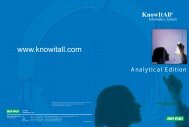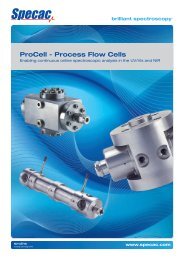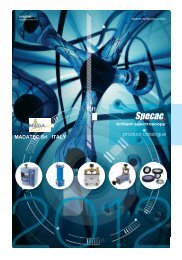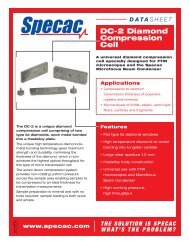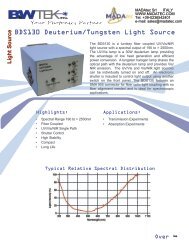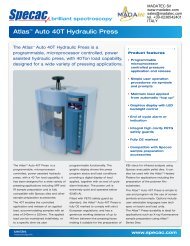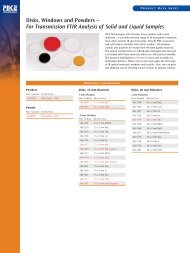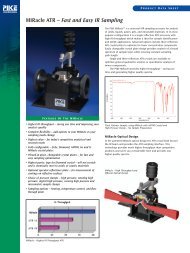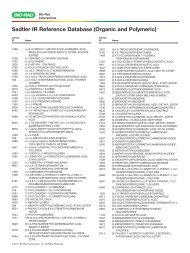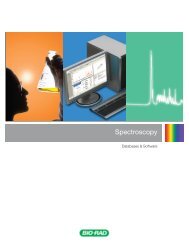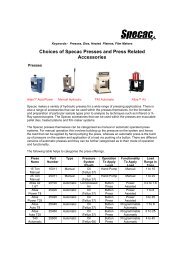Pike Technologies Comprehensive Catalog of FTIR ... - Madatec
Pike Technologies Comprehensive Catalog of FTIR ... - Madatec
Pike Technologies Comprehensive Catalog of FTIR ... - Madatec
You also want an ePaper? Increase the reach of your titles
YUMPU automatically turns print PDFs into web optimized ePapers that Google loves.
P IKE T ECHNOLOGIES WWW. PIKETECH. COM 608-274-2721<br />
Diffuse reflectance spectra <strong>of</strong> ibupr<strong>of</strong>en with and without<br />
Kubelka-Monk conversion<br />
Even with all these sample preparation practices, the raw<br />
diffuse reflectance spectra will appear different from its transmission<br />
equivalent (stronger than expected absorption from weak IR bands).<br />
A Kubelka-Munk conversion can be applied to a diffuse reflectance<br />
spectrum to compensate for these differences. This conversion is<br />
available in most <strong>FTIR</strong> s<strong>of</strong>tware packages.<br />
The Kubelka-Munk equation is expressed as follows:<br />
Where:<br />
R is the absolute reflectance <strong>of</strong> the sampled layer, K is the<br />
molar absorption coefficient and s is the scattering coefficient.<br />
The spectra shown above demonstrate this spectral conversion<br />
for ibupr<strong>of</strong>en collected by diffuse reflectance. The sample was<br />
diluted to about 1% by weight in KBr and mixed using a Wig-L-<br />
Bug. The Kubelka-Munk converted spectrum for ibupr<strong>of</strong>en shows<br />
excellent comparison with the transmission spectrum and is easily<br />
identified using library search <strong>of</strong> a transmission spectral data base.<br />
The Kubelka-Munk equation creates a linear relationship for<br />
spectral intensity relative to sample concentration (it assumes<br />
infinite sample dilution in a non-absorbing matrix, a constant<br />
scattering coefficient and an “infinitely thick” sample layer). These<br />
conditions can be achieved for highly diluted, small particle<br />
samples (the scattering coefficient is a function <strong>of</strong> sample size<br />
and packing) and a sample layer <strong>of</strong> at least 1.5 mm. With proper<br />
sample preparation diffuse, reflectance spectroscopy can provide<br />
ppm sensitivity and high quality results.<br />
Plastic Bumpers and Tough Samples<br />
Sometimes it is necessary to analyze a sample which simply does<br />
not fit in a spectrometer’s sample compartment – the analysis <strong>of</strong><br />
polymer-based automotive components or painted panels are<br />
typical examples.<br />
A special diffuse reflectance technique allows quick and simple<br />
analysis <strong>of</strong> such samples in a relatively non-destructive manner. A<br />
small amount <strong>of</strong> the sample can be collected by abrasion on a<br />
diamond or silicon carbide (SiC) abrasion disk and analyzed<br />
immediately with the help <strong>of</strong> a diffuse reflectance accessory.<br />
The figure above shows the diffuse reflectance spectrum <strong>of</strong> a<br />
automotive body component. The PIKE Abrasion Kit with diamond<br />
sampling disk was rubbed across the large automotive component<br />
which collects some <strong>of</strong> the polymer material into the web <strong>of</strong> the<br />
sampling disk. Spectra were co-added for a 1 minute time period<br />
and ratioed to the diamond disk background spectrum. The<br />
resulting spectrum is <strong>of</strong> excellent quality and is identified as a<br />
polypropylene copolymer.<br />
Diffuse reflectance can also be used for the analysis <strong>of</strong> liquid<br />
samples. In this application a small amount <strong>of</strong> the sample is<br />
dispensed directly onto the KBr powder and analyzed.<br />
Diffuse reflectance spectrum using SiC abrasion disk<br />
For the analysis <strong>of</strong> powders the following procedure is recommended;<br />
• Place about 200-400 mg <strong>of</strong> KBr into a Wig-L-Bug vial and shake<br />
for 30 seconds<br />
• Fill the background diffuse cup with this KBr<br />
• Remove excess KBr with a flat edge – the KBr should be<br />
loosely packed<br />
• Add 1 to 5 mg <strong>of</strong> the sample to the remaining KBr in the<br />
Wig-L-Bug vial and shake for 30 seconds<br />
• Fill the sample diffuse cup with this mixed sample/KBr<br />
• Remove excess sample with a flat edge – the sample should<br />
be loosely packed<br />
• Place the background and sample diffuse cups into the<br />
sample holder<br />
• Slide the sample holder into the accessory<br />
• Position the KBr cup in the beam and collect a background<br />
• Move the holder to the sample position and collect a sample<br />
spectrum (the ratio <strong>of</strong> these two spectra will produce a<br />
spectrum <strong>of</strong> the sample)<br />
• Convert the raw diffuse reflectance spectrum to Kubelka-Munk<br />
Under ideal conditions the transmission <strong>of</strong> the strongest<br />
band in the spectrum should be in the 50% range. If the resulting<br />
bands are too intense or distorted, re-dilute the sample and make<br />
sure that all other measurement affecting factors (particle size,<br />
homogeneity and packing) are within required limits.<br />
Summary<br />
Diffuse reflectance accessories make the analysis <strong>of</strong> a wide range<br />
<strong>of</strong> solid samples easier, faster and more efficient. Advanced options<br />
for diffuse reflectance provide the ability to heat the sample<br />
and monitor a reaction process. Automation versions <strong>of</strong> diffuse<br />
reflectance accessories provide the ability to greatly increase<br />
sample throughput.<br />
36



